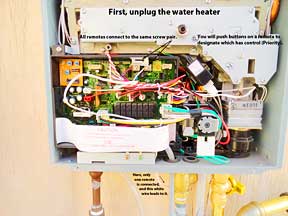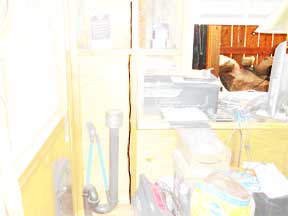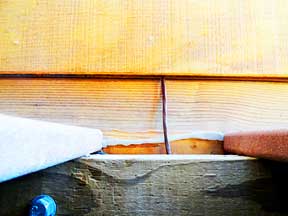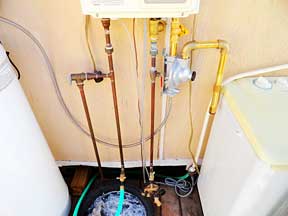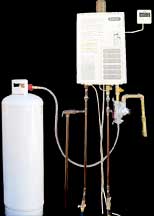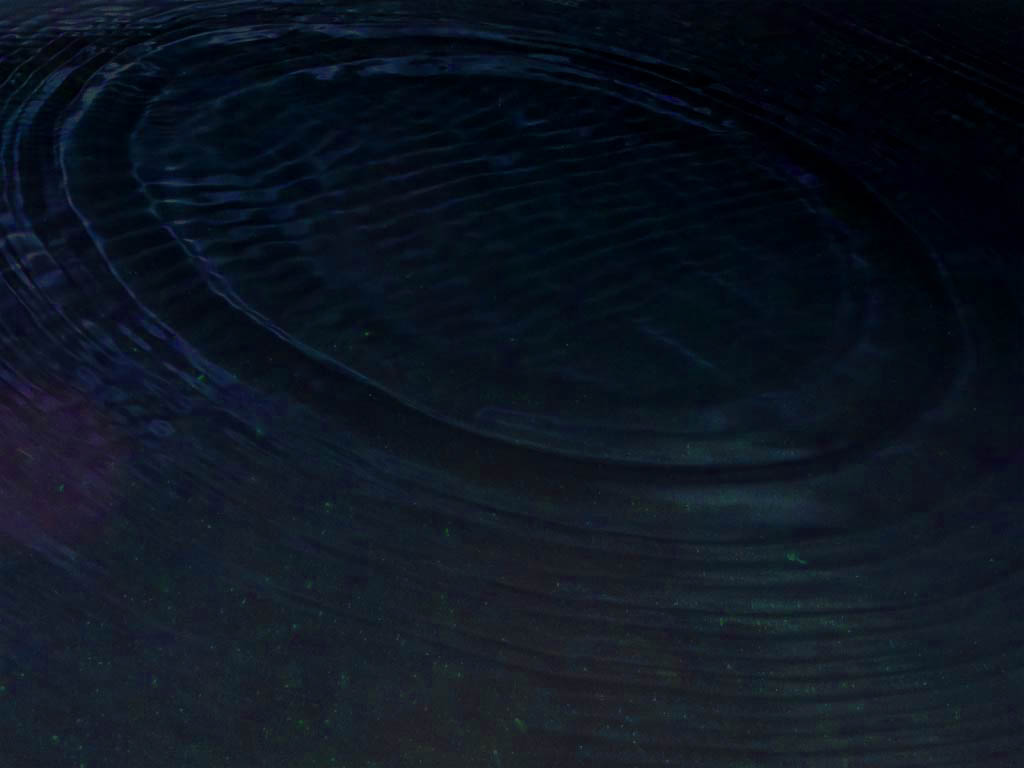 After installing this "Rheem Tankless Water Heater LP Gas" in 2008,
I wrote:
After installing this "Rheem Tankless Water Heater LP Gas" in 2008,
I wrote:
- The 4.2 GPM model has since been discontinued. My guess is they found out that 4.2 doesn't really get it ...
- The heater began cutting off after about a minute into my shower and I would have to wait just as long for it to reset and give me another minute ...
- My wife took a shower. It did not cut off. Huh?! ...
- I called Rheem ...
- The difference is that at 120 degrees I was adding some cold and she was not ...
- Turning on the cold at the shower diverted the water enough to reduce the flow to the heater and shut it off ...
- Now I reduce the water temp at the remote to 108 degrees before I take my shower and only turn on the hot water valve at the shower, and it does not cut off.
Problem solved. Until ...
January, 2012
Suddenly, that no longer works. First thing in the morning, I am in my office at my computer. It is still cold out, but she is in the adjacent shower. The shower water gets cold. She yells. I go out to the remote control next to the water heater and turn it off. Then I turn it on. She completes her shower.
I take my shower early afternoon after the sun has warmed things up. She is usually off running errands. The shower water gets cold. I wrap my towel around my waste, go out to the remote, shut it off, and on, and return to complete my shower. This is a pain.
Junk in the tank
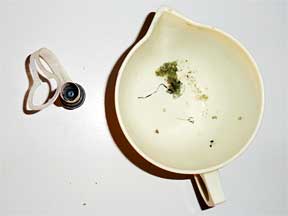
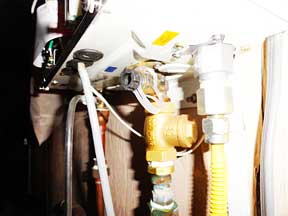
 Studying the manual, I discover that I should have been checking the water filter periodically. I pull the filter and discover that it is full of all kinds of good stuff: a small supply of sand and a lot of plastic spiral squigglys. I had known about the squigglys in our water ever since I had temporarily hired another water delivery service to bring me water. This stuff came out of his truck.
Studying the manual, I discover that I should have been checking the water filter periodically. I pull the filter and discover that it is full of all kinds of good stuff: a small supply of sand and a lot of plastic spiral squigglys. I had known about the squigglys in our water ever since I had temporarily hired another water delivery service to bring me water. This stuff came out of his truck.
My usual service, Wonder Water, had quit delivering to our area because it consumed too much fuel and some roads around here (though not mine) are too rough on the truck. He later changed his mind and decided to resume delivery. He had probably heard from a few other customers also. He raised his price appropriately and resumed bringing me water.
Some of those squigglys are still in the 2600 gallon water tank and occasionally find their way into the pipes. We filter all of our drinking water anyhow, but I have learned to periodically remove the faucet and shower heads and dump the squigglys into the trash. Now the water heater filter will get that too.
But the shower still goes cold.
Fine tuning. Don't!
When I originally installed the system, I foolishly adjusted the dip switches on the circuit board to raise the maximum temperature from the preset 120 degrees to 140 degrees. I realize now that this was a mistake, and that it was unnecessary; 120 degrees is more then hot enough. 140 would just tax the system even more. I am wondering if that casual adjustment may have contributed to my problems. So I unplugged the heater and reset the dip switches to their original settings, hoping I did that right. It has to be done in a very specific manner.
And then I found
this tidbit: "Remember if you raise the temperature setting, risk is that tankless cannot heat water fast enough and unit will start throwing error codes and shutting down. If unit is not working at optimal performance, the raising temperature is bad idea."
It also howls loud when we fill the clothes washing machine. I have not yet found a good reason for this online. Other people get a temporary low pitched moan or grumble.
Throw it out and start over? No!
In March I decided to just replace the water heater, since it has always been kind of limp from the gitgo, with one that provides a stronger flow of water. I decided to get it done professionally since doing it myself would void the warranty, and it would be nice to have somebody to call when things go wrong in the future.
I talked to a local plumber who knows these systems and he wisely asked me if I would have any problem with getting a permit and with inspectors coming around. I replied that indeed I would have a problem with that. Almost everything at my place is DIY and of coarse done very well, to the best of my knowledge, but may be a bit different from the town specs. However, he did suggest some changes I could make that might solve the problem.
Adding some muscle
One change I made was to replace the 20 Lb propane tank with a 100 Lb tank. At first I thought he had told me that the latter provides a stronger outlet pressure to the heater. I must have misunderstood him because what I have found online is that the outlet pressure of each is the same.
|
| Size |
LP Capacity |
Diameter |
Height |
Water Capacity |
Tare Weight |
| 20# | 5 gal | 12.25 | 17.75 | 47.6 Lb | 17 |
| 30# | 7 gal | 12.25 | 23.75 | 71.5 Lb | 25.4 |
| 40# | 10 gal | 12.25 | 29.25 | 95.2 Lb | 33.6 |
| 100# | 25 gal | 14.63 | 48.5 | 239 Lb | 71 |
| Propane 101 "Promoting Propane Safety Through Understanding" : |
- The Water Capacity is how much water the propane bottle will hold in pounds.
|
- The "WC" stamped on the bottle followed by a number such as "47.6" means the bottle will hold 47.6 pounds of water.
|
- The Tare Weight (empty weight) indicated by a "TW" is also followed by a number such as "17" meaning the bottle weighs 17 pounds when empty.
|
- The numbers here would likely be found on a five gallon propane bottle (also known as a 20 pound cylinder) used for a barbeque grill.
|
- A propane bottle that will hold 47.6 pounds of water will hold 20 pounds (5 gallons) of propane.
|
|
|
I guess the "Water Capacity" is just to provide a perspective. May God help us if the propane tank should actually contain any water.
 I found a brand new 100 Lb Worthington tank at Home Depot, though none of their standard variety gas grill regulators fit that tank. The "100 Lb" on the label describes the amount of propane it will hold; not the weight of the tank. The tank actually weighs 68 pounds, so a full tank weighs 168 pounds.
I found a brand new 100 Lb Worthington tank at Home Depot, though none of their standard variety gas grill regulators fit that tank. The "100 Lb" on the label describes the amount of propane it will hold; not the weight of the tank. The tank actually weighs 68 pounds, so a full tank weighs 168 pounds.
I laid it across the back seat of my Prius with its head at the passenger side. I wrapped two seat belts around it and jammed a picnic cooler between it and a front seat just to make sure it would not clobber me if I came to a very sudden stop.
At Yucca Equipment Rental I parked with the passenger side rear door next to their propane filling stand. The attendant had no problem purging and filling the tank while it remained horizontally strapped into the back seat of the car.
 Back home I parked with the drivers side next to the foot high deck, leaving room for the rear door to open wide. I had my hand truck and a web clamp ready but I did not need them. The 168 pound tank slid out of the seat and onto the deck very easily. Wearing tight fitting rubber mesh gloves, I was able get a good grip as I roll walked the tank vertically across the deck to a position adjacent to the tankless water heater hanging on the trailer wall. (The trailer is locked into place on a permanent rack and under a steel carport roof.)
Back home I parked with the drivers side next to the foot high deck, leaving room for the rear door to open wide. I had my hand truck and a web clamp ready but I did not need them. The 168 pound tank slid out of the seat and onto the deck very easily. Wearing tight fitting rubber mesh gloves, I was able get a good grip as I roll walked the tank vertically across the deck to a position adjacent to the tankless water heater hanging on the trailer wall. (The trailer is locked into place on a permanent rack and under a steel carport roof.)
It would sit there for another two weeks before I had adequately researched, ordered and installed the correct regulator.
The new tank did necessitate finding a more compatable and heafty regulator which would connect directly to the water heater rather then to the tank. This is explained further down.
Trying to understand
In researching all this I discovered
a good article that discusses the various regulators that can feed propane to an appliance. The simple little gas grill regulator on my previous configuration with its 1/4" hose was probably not the best option, though I am not sure about that.
One of the first points that the author makes is "Check to see what propane pressure the appliance requires at the inlet ...". This sent me into an entirely different direction that I had not anticipated.
| Page 16: |
A water pressure of 40 psi (276 kPa) is required to achieve maximum flow rate. |
| When the water is supplied from a water supply tank, the height of the tank and the diameter of the pipes and their relation to water pressure should be taken into consideration. |
| Gravity water pressure is not recommended. ( Not good! ) |
| Page 17: |
Notice: If the water flow resistance of a shower head is too high, the burner in the water heater will fail to ignite. Keep the shower head clean from debris that could cause additional pressure drop. |
| Notice: If using mixing valves on the [shower] outlet, choose one that prevents cold water pressure from overcoming hot water line pressure. |
| Notice: Use only teflon tape on cold and hot water connections and lines. |
| Page 19: | If flexible connectors are used, the maximum length shall not exceed 36” (91 cm). |
| The inlet gas pressure to the water heater must not exceed ... 14” w.c. (3.5 kPa) [0.5 psi] for LP gas. |
| For purposes of input adjustment, the minimum inlet gas pressure (with main burner on) is shown on the water heater rating plate. |
and it is: |
Max. inlet gas pressure: 14.0” w.c. Model No. PTG2-42PVP
Min. inlet gas pressure: 8.0” w.c.
Max. input: 118000 BTU/HR
Min. input: 21500 BTU/HR
|
| WARNING: Install a gas pressure regulator in the gas supply line which does not exceed the maximum supply pressure. |
Three pages about water and one about gas. Clearly, Rheem is more concerned about water then gas.
I replaced the multi-function shower head with a simple straight through head so that it will offer minimal resistance to the flow of water.
My shower handle configuration does allow the hot and cold to meet in the middle where they mix and travel up to the shower head. Therefore, where they meet in the middle, the force of the cold is counteracting that of the hot creating some back pressure. That is why it used to stay hot for my wife, who used no cold, but it cut off for me when I was mixing in some cold. I plan to replace that with something more acceptable.
3/25 1:49 Van:
Thank you for your very good article about this subject. I have selected the COM5 but am still too vague about all this, so want to run it by you before I proceed.
I have a Rheem RTG42 [sic: it is a PTG2-42PVP] Indoor tankless water heater - outdoors, which I attached to the side of my trailer under a carport roof in the high desert. It stays dry and relatively dust free.
I installed it in 2008 and it has been barely functional since (weak; very weak water flow). Lately it has begun to cut off half way through whatever we are doing, i.e. I climb out of the shower, shut off the water heater, turn it back on, then complete my shower.
The water heater is currently connected to a 20 LB propane tank through a regulator, yellow 1/4" ID hose and an adapter so that it can connect to the 3/4" gas inlet. I am told that that is my problem.
I have purchased a 100 LB Worthington tank at HD, which the salesman says has the "new" kind of reversed thread 7/8" female connector with a tapered bottom. They do not yet carry the correct regulator.
The Rheem manual says: If flexible connectors are used, the maximum length shall not exceed 36". The inlet gas pressure to the water heater must not exceed 14" w.c. (3.5 kPa) for LP gas. The minimum inlet gas pressure (with main burner on) is shown on the water heater rating plate: Max: 14.0 wc, 118000 BTU/HR Min: 8.0 wc, 21000 BTU/HR.
The COM5 is 3/8". The hose is 2 feet too long but I'm guessing that is okay. I want the ACME Inlet Fitting but it is 1/4". Does it come in 3/8"? There is no gas pilot, so I don't need the dual setup, but if you suggest that, then I'll get another 100 LB tank.
Thanks for your guidance. Van Blakeman
3/26 7:56 Cheyenne:
Van, First off you are using low pressure propane, which mimics natural gas. When using low pressure, your appliance requires a volume of gas since there isn't much pressure. You should have a gas line the same size or larger than the inlet of your appliance. What is happening in your situation is you have a 1/4" ID gas line going to your appliance, then you are expanding the line to 3/4" at the appliance. This is causing a pressure drop there three times less than the pressure in the 1/4" ID hose. When you are not using the water heater the line is pressurized all the way to the heater. Once you start to use the heater, the pressure drops and the gas is seeping into the appliance. Even if you use our COM5 regulator, which has a 3/8" hose, you will still lose 50% of the pressure after you start to use the heater.
I would suggest our GR9412 located on our other website here: https://tejassmokers.com/lowpressureregulators.htm.
Now the way that this works is there is a POL fitting (which can be changed to an ACME) to connect to the tank. After that fitting there is a 5' hose which connects to the regulator. Then the regulator can be plumbed directly to the water heater. The hose that comes with the unit is not too long, and can be 100' if you needed it to be. The reason it can be longer than the 36" is that the hose is before the regulator and is pressurized at tank pressure which can be up or over 100 PSI. Since this is going to be outdoors I would suggest getting stainless steel over braided hose to keep critters from chewing on the hose.
Purchasing this regulator will allow you to tee off before the heater and use another gas appliance if you wanted to. If you have any questions, please respond. Thank you, Cheyenne
3/26 11:11 Van:
Thank you very much for the excellent reply. That is the first suggestion I have gotten that really makes sense. The nice thing about a rubber hose is you can see the cracks five years down the line and replace it. How long is the braided (over rubber?) hose supposed to last?
Anyhow, I will go with your suggestion: GR9412, 3/4" ACME fitting, 5' 3/4" braided hose. What are the order numbers for the latter two? The GR9412 description says "525,000 btu/hr maximum output" and the WH manual says "Max: 118000 BTU/HR". I guess it will regulate that. Right?
I will connect the regulator to the 3/4" female water heater inlet with a short steel [actually brass] gas pipe & teflon. Is that correct? I guess there would be no need for a shutoff ball valve between the regulator & the WH. [Wrong!]
3/26 3:17 Cheyenne:
Van, Excuse me, the hose going from the tank to the regulator is 1/4" ID. It will work just fine since the pressure through it is high. It will be enough to supply the regulator.
The water heater could produce up to 118000 BTU/hr. That measures the heat that the heater will produce. Honestly you can run four of the water heaters with this regulator. If you are only running one it will operate just fine.
The hose will last as long as the standard rubber hose. Yes the stainless is over the rubber. ... I do not have a part number for the hose. The price is $40.00 for the upgrade. If you are making your order online you can go to: http://tejassmokers.com/payment/index.htm and enter 40.00 in the space provided. This will show up as a payment in the shopping cart. During the check-out, there is a comments section where you can copy and paste: "Payment is for the upgrade to a stainless steel over braid hose."
The Acme [fitting] you should use is the red one. The part number is 204077 and is located here: http://tejassmokers.com/gasregulators.htm. We will install it to the hose for you.
For the regulator to the WH you can use 3/4" pipe and Teflon tape or pipe dope. I would recommend a shut off in between the two. It is better to be safe than sorry. You will also have to mount the regulator with the outlet facing down.

|
| Order Date | Order Amount |
Mon Mar 26, 2012
| $184.50 |
| Quantity |
Item Number |
Description |
Price |
Extended |
| 1 |
GR-9412 |
Twin Stage low pressure 525,000 btu regulator with 5 ft hose and full flow tank fitting and mounting bracket
Inlet Hose : 5 ft 132.50
|
$132.50 |
$132.50 |
| 1 |
204077 |
Red ACME inlet fitting
|
$12.00 |
$12.00 |
| 40 |
PAYMENT |
Payment for shipping or specially quoted custom item. |
$1.00 |
$40.00 |
|
|
|
Cart Subtotal: |
$184.50 |
|
|
|
Shipping |
$0.00 |
|
|
|
State Tax: |
$0.00 |
|
|
|
Total: |
$184.50 |
|
|
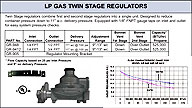 These are the full descriptions:
These are the full descriptions:
Low Pressure Twin Stage Regulator GR-9412
Manufacturer: Fairview Fittings and Manufacturing, 3777 COMMERCE COURT, WHEATFIELD, NY 14120
LP GAS TWIN STAGE REGULATOR: 1/4 FPT Inlet 3/4 FPT Outlet, 525,000 BTU/HR Capacity
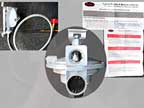
Distributor: GasHosesandRegulators.com, Tejas Smokers Inc
Twin stage regulators combine first and second stage regulators into a single unit. They are designed to reduce tank pressure to a preset 11" WC delivery pressure. Manually adjustable from 9 to 13" WC. Equipped with 1/8" FNPT pressure gauge taps on inlet and outlet for easy system pressure checks. Supplied with a 60" thermoplastic high pressure hose outfitted with a model 204051 Full Flow, POL tank connector. Gas outlet is 3/4" FNPT. Flexible 3/4"ID low pressure outlet gas hoses may be found on our Natural Gas Hose webpage. Supplied with GR-905 mounting bracket. Dimensions: 7.5"L x 5.5"W x 4.75"H, Weight 3# 15 oz.
525,000 btu/hr maximum output Perfect for small cabins using portable tanks.
I also purchased a POL to GCC adapter from G K Propane nearby in Yucca Valley. This adapter connects the Red ACME inlet fitting to the 100 Lb tank.
To paraphrase an article on eHow.com, "Two Stage Propane Regulator Input & Output":
The first stage, or high pressure regulator, changes the liquid propane into a high pressure gas.
The second stage, the low pressure regulator, reduces the high pressure gas to appropriate pressure levels for appliances and furnaces.
By separating the high pressure and the low pressure regulators, the gas is more efficiently transported from the tank to the appliance.
As explained in the above conversation, the 3/4" outlet of the new regulator is equal in size to the inlet of the water heater so that the regulator itself will not restrict the flow of propane, as the previous 1/4" regulator may have. Apparently, if the burner was not being supplied with enough propane, it could shut itself down, which would explain my problem.
On the other hand, the above article states that propane gas naturally flows at a high pressure, which can vary with temperature, etc.. So all regulators, regardless of size, monitor and reduce the gas to the consistent relatively low pressure required by the appliance.
This Rheem water heater requires a minimum input of 21,500 BTU/HR and a maximum of 118,000 BTU/HR.
A search for various examples of 1/4" gas grill regulators found the following. All have a 11" w.c. output:
- Weber 7501 Regulator for up to 38,000 BTUs
- Char-Broil 4584657 Regulator for up to 65,000 BTUs
- A Mr. Heater low pressure regulator has a 75,000 BTU capacity.
- A Camco low-pressure Single Stage Regulator is rated for 200,000 BTU/HR.
- A Muellar Hi Pressure Regulator can be adjusted up to 2,000,000 BTU for a Cajun burner.
Of course the latter two might burn the system out, but the others all exceed the minimum input of 21,500 BTU/HR, so why won't they work? I must be missing something here.
10/09 12:20 Van:
Hi Cheyenne, Did everything suggested, but with no improvement. The shower still cuts out.
Now I am wondering exactly what you meant when you said "You will also have to mount the regulator with the outlet facing down". What do you mean? I assumed that you were referring to the vent pipe so that it can't take in rain water. If you meant that the gas outlet to the heater immediately above it, then that would be pretty tricky. Are the internal mechanisms dependent on gravity? Can you explain how or why?
I have attached a picture of my new setup. Can you tell me what is wrong with it? I can send a broader perspective of it too, if you would like that.
I am also writing an article about the whole experience for my web site, primarily to help me pull it together and figure out what is going on, or not. I will send you a link when it is done. Thanks, Van
10/09 12:34 Cheyenne:
Van, I meant the vent is facing down, which should put the outlet of the regulator facing down as well.
Although it should work as you have it, I would try turning the regulator 180 degrees. This way you will have the vent facing vertically down, then you will have the gas to 90 twice into the heater.
If that doesn't work, I would say there is a problem with the water heater.
We can try to trouble shoot it over the phone if you would like. Cheyenne 713.222.0077
Remote control two
The most inconvenient part of that is having to leave the shower room to reset the remote. So I ordered a 2nd remote, the USC1-117, from PlumberSurplus.com.
I also bought a spool of 18-5 thermostat wire locally. While waiting for the remote, I looped one end of the wire around a pipe at the water heater and ran it under the deck and up inside the shower wall adjacent to where I planned to put the remote.
When the remote arrived, I connected it inside the shower room. I fed the other end of the wire up into the open circuitry of the unplugged water heater and attached the two leads to the same screw pair that the main remote control (UMC-117) was already attached to.
To use the 2nd remote, you turn it on to give it priority, and off to release control back to the main remote.
PalomaStore.com says: "This remote allows you select a temperature for your bath or shower independently of the main remote. Simply turn on the USC1-117 and the setting will be changed to the temperature you have set the USC1-117 to. When you turn the USC1-117 off, control is automatically restored to the Main Controller. "
I also found an interesting and well done interactive depiction of how a Rinnai tankless water heater works internally at FineHomebuilding.com, a magazine that seems to provide just about everything you might want to know about home building.
Other notes found elsewhere:
27.7 inches of water column = 1 pound per square inch (psi). 8" w.c. = 0.288 psi. 14" w.c. = 0.50578208558 psi
A full 20-lb. propane tank weighs 38 lbs., while an empty one weighs 18 lbs.
A full 100-lb. propane tank weighs 168 lbs., an empty one weighs 68 lbs.
There is
a video online about how to flush out the water heater with vinegar and a rented sump-pump. Apparently I should have been doing this about once a year.
Perhaps:
Having been designed to include a vent stack, could the lack of the stack affect water and/or propane pressure sensors?
Could being almost at the altitude level that would require an "altitude chip" in the circuit board affect the pressure sensors? Their tech says no.
Is the water pressure from the tank, which is 30' higher in altitude, too low? If so, then a higher GPM model would make no difference. I may have to install an inline water pump just to find out. Actually I guess I could hook up a Flow & Pressure Gauge to get some readings on that first. The manual says it needs 40 psi. The gallons per minute would be interesting also.
As I write this, I am 3000 miles away. When I return, I plan to give the Error codes another serious look, now that compiling this has helped me get my head around it.
|
